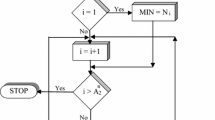Abstract
Cell formation is the first step in the design of cellular manufacturing systems. The main objective of this step is to cluster machines and parts into machine cells and part families respectively so that the minimum of intercellular part movements will be achieved. In this paper, we will focus on the configuration of machine cells considering production volumes and process sequences of parts. Also, we will study alternative process routings for part types and machine reliability considerations. A pure linear integer program will be developed to formulate this situation. The results of solving numerical examples show that the reliability consideration has significant impacts on the final block diagonal form of machine-part matrixes.
Similar content being viewed by others
References
Yin Y, Yasuda K, Hu L (2005) Formation of manufacturing cells based on material flows. Int J Adv Manuf Technol 27:159–165
Wemmerlov U, Hyer NL (1986) Procedures for the part family/machine group identification problem in cellular manufacturing. J Oper manage 6 (2):125–147
Reisman A, Kumar A, Motwani J, Cheng C (1997) Cellular manufacturing: a statistical review of the literature. Oper Res 45:508–520
Selim HM, Askin RG, Vakharia AJ (1998) Cell formation in group technology: review evaluation and directions for future research. Comput Ind Eng 34:3–20
Yin Y, Yasuda K (2005) Similarity coefficient methods applied to the cell formation problem: a taxonomy and review. Int J Prod Eco DOI 10.1016/j.ijpe.2005.01.014
Waghodekar PH, Sahu S (1984) Machine-component cell formation in group technology; MACE. Int J Prod Res 22(6):937–948
Ferreira Ribeiro JF, Pradin B (1993) A methodology for cellular manufacturing design. Int J Prod Res 31(1):235–250
Kitaoka M, Nakamura R, Serizawa S, Usuki J (1999) Multivariate analysis model for machine-part cell formation problem in group technology. Int J Prod Eco 60:433–438
Gupta T, Seifoddini H (1990) Production data based similarity coefficient for machine-component grouping decision in the design of a cellular manufacturing system. Int J Prod Res 28(7):1247–1269
Jayakrishnan Nair G, Narendran TT (1999) ACCORD: A bicriterion algorithm for cell formation using ordinal and ratio-level data. Int J Prod Res 37(3):539–556
Gupta T (1993) Design of manufacturing cells for flexible environment considering alternative routings. Int J Prod Res 31(6):1259–1273
Choobineh F (1988) A framework for the design of cellular manufacturing systems. Int J Prod Res 26(7):1161–1172
Akturk MS (1996) A note on the whiten-cell layout problem based on operation sequences. Prod Plan Control 7(1):99–103
Jayakrishnan Nair G, Narendran TT (1998) CASE: A clustering algorithm for cell formation with sequence data. Int J Prod Res 36(1):157–179
Sarker BR, Xu Y (2000) Designing multi-product lines: job routing in cellular manufacturing systems. IIE Trans 32:219–235
Steudel HJ, Ballakur A (1987) a dynamic programming based heuristic for machine grouping in manufacturing cell formation. Comput Ind Eng 12(3):215–222
Eid Moussa S, Kamel M (1998) A part-machine assignment algorithm for cellular manufacturing with machine capacity constraints. Comput Ind Eng 35(3–4):483–486
Caux C, Bruniaux R, Pierreval H (2000) Cell formation with alternative process plans and machine capacity constraints: a new combined approach. Int J Prod Eco 64:279–284
Sule DR (1991) Machine capacity planning in group technology. Int J Prod Res 29(9):1909–1922
Nagi R, Harhalakis G, Proth JM (1990) Multiple routings and capacity considerations in group technology application. Int J Prod Res 28(12):2243–2257
Kusiak A (1987) The generalized group technology concept. Int J Prod Res 25:561–569
Kazerooni M, Luong HS, Abhary K (1997) A genetic algorithm based cell design considering alternative routing. Comput Integ Manuf Sys 10(2):93–107
Arkat j, Saidi M, Abbasi B (2006) Applying simulated annealing to cellular manufacturing system design. Int J Adv Manuf Technol DOI 10.1007/s00170-005-0358-5
Kim CO, Baek JG, Baek JK (2004) A two-phase heuristic algorithm for cell formation problems considering alternative part routes and machine sequences. Int J Prod Res 42(18):3911–3927
Zhao C, Wu Z (2000) A genetic algorithm for manufacturing cell formation with multiple routes and multiple objectives. Int J Prod Res 38(2):385–395
Lozano S, Guerrero F, Eguia I, Onieva L (1999) Cell design and loading in the presence of alternative routing. Int J Prod Res 37(14):3289–3304
Adil GK, Rajamani D, Strong D (1996) Cell formation considering alternate routings. Int J Prod Res 34(5):1361–1380
Diaz BA, Lozano S, Racero J, Guerrero F (2001) Machine cell formation in generalized group technology. Comput Ind Eng 41:227–240
Won Y (2000) New p-median approach to cell formation with alternative process plans. Int J Prod Res 38(1):229–240
Hwang H, Ree P (1996) Routes selection for the cell formation problem with alternative part process plans. Comput Ind Eng 30(3):423–431
Sofianopoulou S (1999) Manufacturing cells design with alternative process plans and/or replicate machines. Int J Prod Res 37(3):707–720
Sarker BR, Li Z (1998) Measuring matrix-based cell formation with alternative routings. J Oper Res Society 49(9):953–965
Venugopal V, Narendran TT (1992) A genetic algorithm approach to the machine-component grouping problem with multiple objectives. Comput Ind Eng 22(4):469–480
Felix TSC, Lau KW, Chan PLY, Choy KL (2005) Two-stage approach for machine-part grouping and cell layout problems. Robot Comput Integr Manufacturing DOI 10.1016/j.rcim.2005.04.002
Author information
Authors and Affiliations
Corresponding author
Rights and permissions
About this article
Cite this article
Saeed Jabal Ameli, M., Arkat, J. Cell formation with alternative process routings and machine reliability consideration. Int J Adv Manuf Technol 35, 761–768 (2008). https://doi.org/10.1007/s00170-006-0753-6
Received:
Accepted:
Published:
Issue Date:
DOI: https://doi.org/10.1007/s00170-006-0753-6



